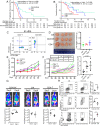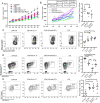CD4+ T cells are required to improve the efficacy of CIK therapy in non-small cell lung cancer
- PMID: 35523765
- PMCID: PMC9076680
- DOI: 10.1038/s41419-022-04882-x
CD4+ T cells are required to improve the efficacy of CIK therapy in non-small cell lung cancer
Abstract
As a widely studied adoptive treatment method, CIK (cytokine-induced killer cells) treatment has shown clinical benefits in many clinical trials on non-small cell lung cancer. As a heterogeneous cell population, however, CIK cells have a strong instability and individual differences in their efficacies, which are collaboratively regulated by the tumor microenvironment and CIK subpopulations. Among them, CD4+ T cells belong to a crucial subgroup of the CIK cell population, and their influence on CIK therapy is still unclear. Herein, we show how CD4+ T cells positively regulate the functions of CD3+CD56+ T and CD3+CD8+ T cells. During this process, we found that Th1/Th17 CD4+ subgroups can induce the phosphorylation of the AKT pathway by secreting IL-17A, and upregulate the expression of T-bet/Eomes transcription factors, thereby restoring the function of CD8+/CD3+CD56+ T cells and reversing the exhaustion of PD-1+Tim-3+ T cells. These findings will provide guidance for the clinical screening of suitable populations for CIK treatment and formulation of strategies for CIK therapy plus immune checkpoint treatment. Based on these findings, we are conducting an open-label phase II study (NCT04836728) is to evaluate the effects of autologous CIKs in combination with PD-1 inhibitor in the first-line treatment of IV NSCLC, and hope to observe patients' benefits in this clinical trial.
© 2022. The Author(s).
Conflict of interest statement
The authors declare no competing interests.
Figures






Similar articles
-
Combination of DC/CIK adoptive T cell immunotherapy with chemotherapy in advanced non-small-cell lung cancer (NSCLC) patients: a prospective patients' preference-based study (PPPS).Clin Transl Oncol. 2019 Jun;21(6):721-728. doi: 10.1007/s12094-018-1968-3. Epub 2018 Oct 29. Clin Transl Oncol. 2019. PMID: 30374838
-
Adoptive immunotherapy of cytokine-induced killer cell therapy in the treatment of non-small cell lung cancer.PLoS One. 2014 Nov 20;9(11):e112662. doi: 10.1371/journal.pone.0112662. eCollection 2014. PLoS One. 2014. PMID: 25412106 Free PMC article.
-
Adjuvant cytokine-induced killer cell immunotherapy improves long-term survival in patients with stage I-II non-small cell lung cancer after curative surgery.Cytotherapy. 2023 Feb;25(2):202-209. doi: 10.1016/j.jcyt.2022.10.008. Epub 2022 Nov 12. Cytotherapy. 2023. PMID: 36379882
-
The dual-functional capability of cytokine-induced killer cells and application in tumor immunology.Hum Immunol. 2015 May;76(5):385-91. doi: 10.1016/j.humimm.2014.09.021. Epub 2014 Oct 8. Hum Immunol. 2015. PMID: 25305457 Review.
-
Effectiveness and safety of chemotherapy with cytokine-induced killer cells in non-small cell lung cancer: A systematic review and meta-analysis of 32 randomized controlled trials.Cytotherapy. 2019 Feb;21(2):125-147. doi: 10.1016/j.jcyt.2018.10.011. Epub 2018 Dec 14. Cytotherapy. 2019. PMID: 30554868
Cited by
-
Cytokine-induced killer (CIK) cells, successes and challenges: report on the first international conference dedicated to the clinical translation of this unique adoptive cell immunotherapy.Cancer Immunol Immunother. 2024 Jan 27;73(2):21. doi: 10.1007/s00262-023-03605-1. Cancer Immunol Immunother. 2024. PMID: 38279995 Free PMC article.
-
PPAR-γ/NF-kB/AQP3 axis in M2 macrophage orchestrates lung adenocarcinoma progression by upregulating IL-6.Cell Death Dis. 2024 Jul 26;15(7):532. doi: 10.1038/s41419-024-06919-9. Cell Death Dis. 2024. PMID: 39060229 Free PMC article.
-
Cytokine-induced killer cells: new insights for therapy of hematologic malignancies.Stem Cell Res Ther. 2024 Aug 13;15(1):254. doi: 10.1186/s13287-024-03869-z. Stem Cell Res Ther. 2024. PMID: 39135188 Free PMC article. Review.
-
Advancing Immunotherapy in Pancreatic Cancer: A Brief Review of Emerging Adoptive Cell Therapies.Cancers (Basel). 2025 Feb 9;17(4):589. doi: 10.3390/cancers17040589. Cancers (Basel). 2025. PMID: 40002184 Free PMC article. Review.
-
Inhibition of human gastric cancer growth by cytokine-induced killer cells plus chemotherapy with or without cadonilimab in a mouse xenograft tumor model.Front Immunol. 2025 Jun 5;16:1609320. doi: 10.3389/fimmu.2025.1609320. eCollection 2025. Front Immunol. 2025. PMID: 40539041 Free PMC article.
References
-
- Li Y, Wang C, Xu M, Kong C, Qu A, Zhang M, et al. Preoperative NLR for predicting survival rate after radical resection combined with adjuvant immunotherapy with CIK and postoperative chemotherapy in gastric cancer. J Cancer Res Clin Oncol. 2017;143:861–71. doi: 10.1007/s00432-016-2330-1. - DOI - PMC - PubMed
-
- Zhao P, Bu X, Wei X, Sun W, Xie X, Li C, et al. Dendritic cell immunotherapy combined with cytokine-induced killer cells promotes skewing toward Th2 cytokine profile in patients with metastatic non-small cell lung cancer. Int Immunopharmacol. 2015;25:450–6. doi: 10.1016/j.intimp.2015.02.010. - DOI - PubMed
Publication types
MeSH terms
LinkOut - more resources
Full Text Sources
Medical
Research Materials

